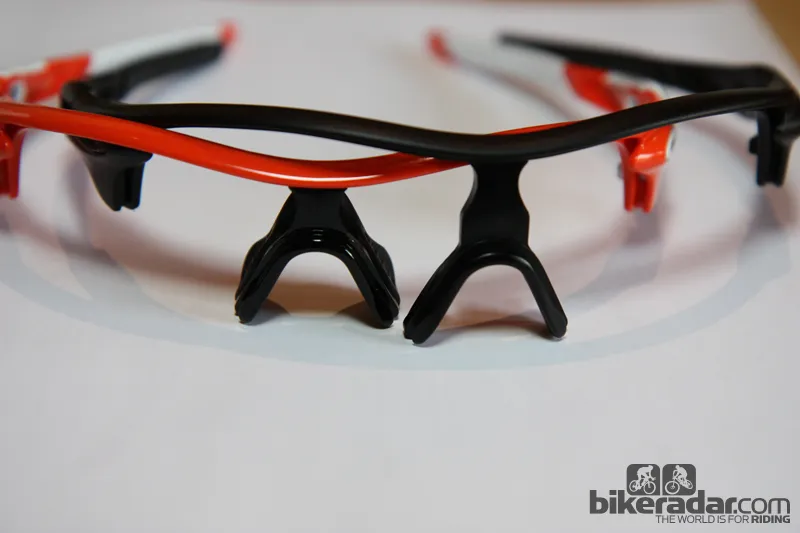Today, Oakley launch the fourth member of their Switchlock collection of interchangeable-lens eyewear with the introduction of a new Radarlock model, which will arrive in stores beginning this summer.
Radarlock’s styling is similar to the current Radar — which will remain in the lineup — but a clever hinge mechanism makes for easier lens changes and according to Oakley, even less lens distortion than before for more accurate optical performance.
The Switchlock technology incorporated into Radarlock is similar in concept to Oakley's Jawbone model — which, notably will revert back to the Racing Jacket moniker and get new earstocks in 2012 — in that there's an actual, hinged mechanism built into the frame that secures the lens in place. The hinge allows for easier lens swaps without the use of force. Radarlock's execution is quite different, though, and the styling is far more subdued than Jawbone's decidedly in-your-face aesthetic.

Catharine Pendrel (Luna) wore the new Oakley Radarlock glasses at the opening round of the UCI MTB World Cup in Pietermaritzburg, South Africa
In this case, users simply slide over a small switch on the inner surface of the frame and then pivot the earstem back. When the switch is engaged, the edge of the frame pivots along with the earstem, removing the fixing pin for the lens and allowing it to easily pull away from the frame. Oakley engineer Ryan Calilung, told BikeRadar, that he originally designed a fully symmetrical system with two sets of hinges but eventually realized it wasn't necessary so production models use a simpler fixed pin on the opposite side.
Swapping lenses on Radarlock is far easier in practice than it seems on paper and while we've never had issues with the standard Radar system ourselves, it's a notably less violent process here. In other words, Radarlock users won't be nearly as likely to cringe in fear of breaking something when switching tints — you unfortunately still have to touch the lens with your fingers, but it feels downright civilized in comparison.

Radarlock's Switchlock feature
Oakley will offer Radarlock in both standard and XL lens sizes with the latter offering several millimeters more height for time trial/triathlon specialists or anyone who simply desires a bigger field of view. Lateral coverage is identical on both and in fact, the frames only differ by their nosepieces.
Technically speaking, the nose bridges are interchangeable but Oakley doesn't recommend owners attempt it on their own — the technique is a bit tricky and Calilung says the plastic can only withstand a finite number of swaps — so consumer frames will be specific for a particular lens size.
In either case, though, Oakley will offer the usual "Asian fit" nosepiece pads to help custom-tune the fit.

Oakley will offer Radarlock in both standard and XL fits with the latter option offering more lens coverage, particularly up top. The frames differ only in the nose piece but Oakley doesn't intend for the pieces to be user-swappable. As before, standard and Asian-fit nose pads will be available, too
Despite a shared aesthetic between Radarlock and Radar, the lenses aren't interchangeable between the two families. Earstem length is unchanged as well but the overall flex pattern is a little more even so riders with wider heads should experience less unpleasant pinching. One side benefit of Radarlock's more complex, multi-piece construction, however, is the infusion of more colors for greater customization potential.
Radarlock will be offered in nine standard frame colors and there will be twelve lens tints in total including polarized, Iridium, and photochromic shades. Standard Radarlock kits will include two lenses while photochromic models will include just one. Pricing will range from US$220-300/£195-235/€239-289 with upcharges for custom options.
New casual sport prescription Crosslink model
Joining Radarlock for 2012 is the new Crosslink frame, boasting a more casual everyday look for prescription wearers but also more sport-oriented features for riders that don't necessarily want to go all-out appearance-wise when they hop on the bike.

The Crosslink features quick-change earstems to change its look almost instantly (two sets of earstems come with each frame); loud and proud for your activities, and more subdued for back in the office after the lunch ride
The three-point fit is similar to Oakley's more bike-specific pieces with hydrophilic 'Unobtainium' covers on the straight earstems and interchangeable standard/Asian-fit nosepieces for a secure hold even when wet. Adding a bit of customization and flair are multiple frame colors, each with interchangeable temples (one additional set is included) covered in contrasting shades.
The standard Crosslink is made of Oakley's standard O Matter plastic and will cost US$180/£130/€170-180.









